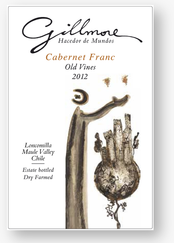Gillmore, Maule Valley (Chile), Cabernet Franc “Old Vines” 2012 (Global Vineyard Importers, $40) and Maquis, Colchagua Valley (Chile) “Franco” Cabernet Franc 2011 (Global Vineyard Importers, $85): When someone tells me that he or she has a good wine from Cabernet Franc, I am immediately interested. Compared to Cabernet Sauvignon, the production of Cabernet Franc is small and isolated enough that every Cabernet Franc wine from the New World piques my curiosity. The best wines are more flavorful and sprightly than most Cabernet Sauvignons, with enticing fresh fruitiness and yet enough weight to be considered serious wines.
Larry Challacombe, President of Global Vineyard Wine Importers in Berkeley, oversees a large portfolio of wines from artisanal family wineries in South America. He pointed out that several of his Chilean wineries have embraced Cabernet Franc and produce varietal Cabernet  Franc wines, while many others are relying on this grape as part of their blends. He believes that the growing acreage of Cab Franc in Chile signals increasing importance of this variety in South America.
Franc wines, while many others are relying on this grape as part of their blends. He believes that the growing acreage of Cab Franc in Chile signals increasing importance of this variety in South America.
I tasted four of Larry’s varietally labelled Chilean Cabernet Franc wines that range in price from $14 to $85 a bottle and, in production volume, from eleven thousand cases to just 500 cases. Every one of them was a terrific wine worth buying, even the $14 everyday entry, 2014 Calcu Cabernet Franc Reserva Especial from Colchagua Valley. This wine is particularly aromatic with floral notes, delicate red fruits, dark berries, sweet spices, chocolate and tarragon. Its acidity is refreshing and its noticeable tannin does not overtake the wine’s enticing fresh fruit. Not surprisingly, it is the lightest wine of the four, but medium-bodied nonetheless, and frankly dry. How many $14 wines deserve 89 points?
Two of the wines come from Viña Maquis, an estate winery in Colchagua whose vineyard is bordered by two rivers that together funnel coastal breezes inland. The Cabernet Franc vines occupy the coolest site on the estate, and the two Cab Franc wines in fact share a remarkable freshness and vibrancy of fruit that would seem to be derived from a cool terroir, as well as from winemaking that’s focused on retaining freshness of flavor. The 2014 Maquis Cabernet Franc ($20) shows compact and concentrated fruit — blackberry, black cherry, plum, with clove and chocolate — that’s woven with toasty oak notes and edgy tannins. This is a very structured red wine and yet the fruit holds its own in the balance. Freshness, flavor, concentration and structure are the hallmarks of this wine, and I rate it at 90 points.
The 2011 Maquis “Franco” Cabernet Franc ($85) is a stunning wine. Take the style of the less expensive Maquis Cab Franc, smooth the tannins into silk, add tertiary character of dried berries and savory notes, lengthen the finish, and plump the wine with richness from its core — and you have this powerful but smooth, compact but complete Cabernet Franc. What remains identifiably Cabernet Franc in this wine (apart from its general greatness-traits) is its vibrancy and its lingering notes of red fruits.
The final Chilean Cabernet Franc that I tasted is my favorite, a choice that revolves around style and to some extent value. That wine is the 2012 Gillmore Cabernet Franc Old Vines ($40) from Maule, a southern Chilean region that is increasingly garnering attention for its very old vines and its cool climate. Sandwiched between the two Maquis wines in my tasting line-up, this wine stood out as a smoother, softer, less powerful and intense style of Cab Franc. While structure and intensity are key characteristics of the three wines from Colchagua, this wine is about aromas and flavors and integration. On your nose and in your mouth, it suggests roses, red cherries, red berries, smoke, and sweet spices. The wine’s tannin is gentle and well integrated. Unfettered by youthful tannin, the wine’s fruit grows in your mouth, gaining weight and showing its purity. Although its flavors are those of Cabernet Franc, this wine seems a bit Burgundian in texture and structure. It tastes of its grapes, while its winemaking takes a back seat.
All four of these wines show impressive fruit quality and suggest great potential for Cabernet Franc in Chile.
2011 Maquis “Franco,” 93 Points
2012 Gillmore “Old Vines,” 93 Points
